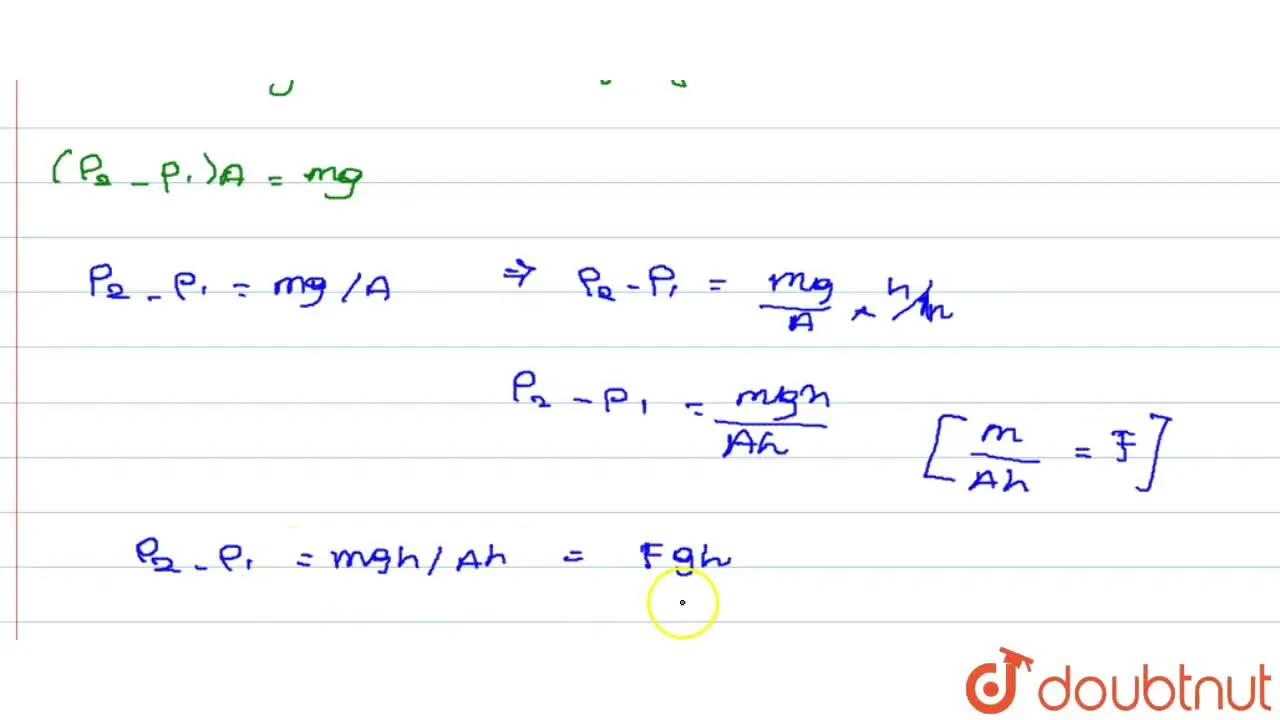Derive an equation for the total pressure at a depth 'h' below the liquid surface.Solution in Tamil
Consider a water sample of cross sectional area in the form of cylinder. Let h1 and h2 be the depths from th e air -water interface to level I and the 2 of the cylinder, respectively as shown in Figure(a). Let F1 be the force acting downwards on level 1 and F2 be the force acting upwards on level 2, such that, F1=P1 A and F2=P2 A the mass of the sample to be m and under equilibrium condition, the total upward force (F2) is balanced by the total downward force (F1+mg), i.e., the gravitational force will act downward which is being exactly balanced by the difference between the force F2−F1
F2−F1=mg=FG
where m is the mass of the water available in the sample element. Let ρ be the density of the water then, the mass of water available in the sample element is
m=ρV=ρA(h2−h1)
V=A(h2−h1)

Hence, gravitational force
FG=ρA(h2−h1)g
On substituting the value of W in equation
F2=F1+mg⇒P2A=P1A+ρA(h2−h1)g
Cancelling out A on both sides,
P2=P1+ρ(h2−h1)g
The level 1 at the surface of the liquid (i.e., air-water interface) and the level 2 at a depth 'h' below the surface (as shown in Figuer (b)), then the value of h1 becomes zero (h1=0). and P1=Pa atmospheric pressure (say Pa). In the pressure (P2) at a depth becoes P. Substituting these values in equation.
P=Pa+ρgh
which means, the pressure at a depth h is greater than the pressure on the surface of the liquid, where Pa is the atmospheric pressure which is equal to 1.013×105Pa. If the atmospheric pressure is neglected or ingnored, then
P=ρgh

Related Playlists
- BOOK - SURA PUBLICATIONCHAPTER - PROPERTIES OF MATTEREXERCISE - IV. Numercial Problems :5videos
PROPERTIES OF MATTER
- BOOK - SURA PUBLICATIONCHAPTER - PROPERTIES OF MATTEREXERCISE - V. Conceptual Questions :5videos
PROPERTIES OF MATTER
- BOOK - SURA PUBLICATIONCHAPTER - PROPERTIES OF MATTEREXERCISE - Short Answers29videos
PROPERTIES OF MATTER
- BOOK - SURA PUBLICATIONCHAPTER - OSCILLATIONSEXERCISE - VALUE BASED QUESTIONS2videos
OSCILLATIONS
- BOOK - SURA PUBLICATIONCHAPTER - PUBLIC EXAM QUESTION PAPER MARCH-2019EXERCISE - Part-IV10videos
PUBLIC EXAM QUESTION PAPER MARCH-2019
Similar Questions
A cappilary of diameter d mm is dipped in water such that the water rises to a height of 30 mm. If the radius of the capillary is made (23) of its previous value, then compute the height up to which water will rise in the new capillary ?
06:08View SolutionWhy coffee runs up into a sugar lump (a small cube of sugar) when one corner of the sugar lump is held in the liquid?
01:39View SolutionDefine stress and strain.
View SolutionStudent in a class were asked by their science teacher about different types of motion , with Examples. But few students were confused with explanation ,for example . Periodic motion. SHM , Oscillatory motion , Rotational motion. SHM , Oscillatory motion . Periodic motion, etc. How would have the teacher explained , so the students understood easily ?
(i) What are path difference & phase difference ?
(ii) For the waves , given below find out the phase & path differences.
 View Solution
View SolutionThe force F acting on a body moving in a circular path depends on mass of the body (m) velocity(v) and radius (r) of the circular path. Obtain the expression for the force by dimensional analysis method (k=1)
03:34View SolutionA beaker containing a liquid of density rho moves up with an acceleration a . The pressure due to the liquid at a depth h below the free surface of the liquid is.
03:34View SolutionThe pressure at depth h below the surface of a liquid of density ρ open to the atmosphere is
View SolutionCalculate the pressure at a depthe 'h' in a liquid.
02:26View SolutionPressure at a depth 'h' in a liquid is ………….
02:26View SolutionHow does liquid pressure depend on the depth of a point below the surface of a liquid
01:22View SolutionHow does liquid pressure depend on the depth of a point below the surface of a liquid
05:36View SolutionDerive an expression for the total pressure at a depth 'h' below the liquid surface.
09:13View SolutionThe pressure in a liquid at a given depth below the surface ………….. .
01:43View SolutionThe pressure in a liquid at a given depth below the surface ………….. .
05:53View SolutionThe pressure at depth h below the surface of a liquid of density rho open to the atmosphere is
05:44View Solution


